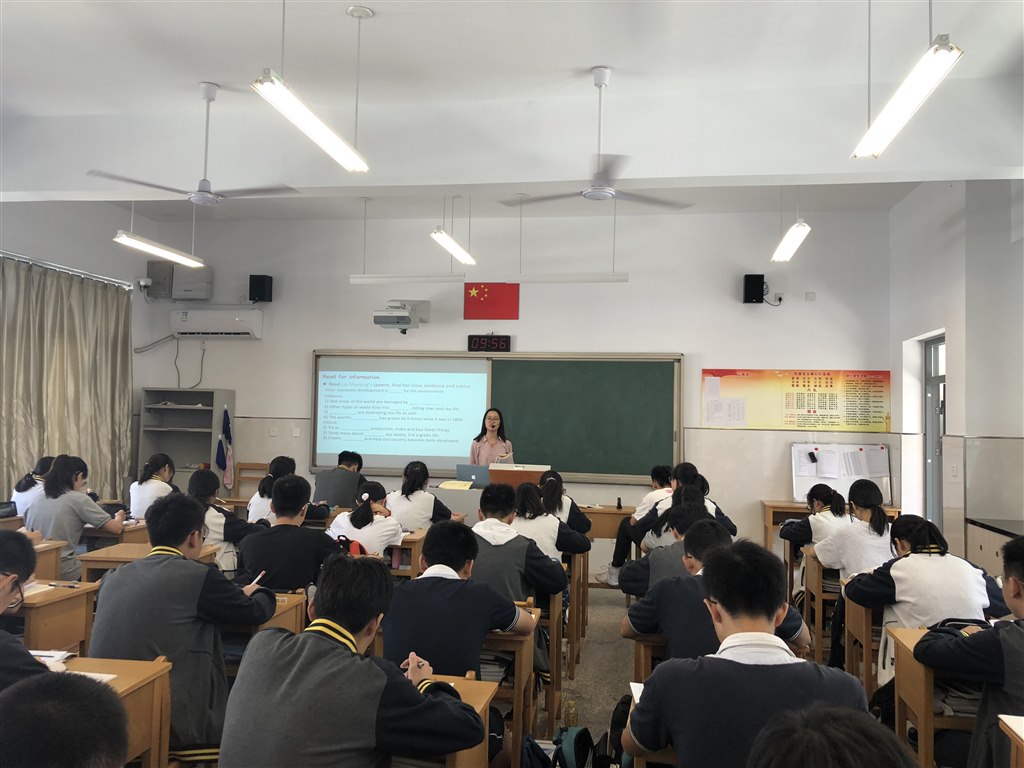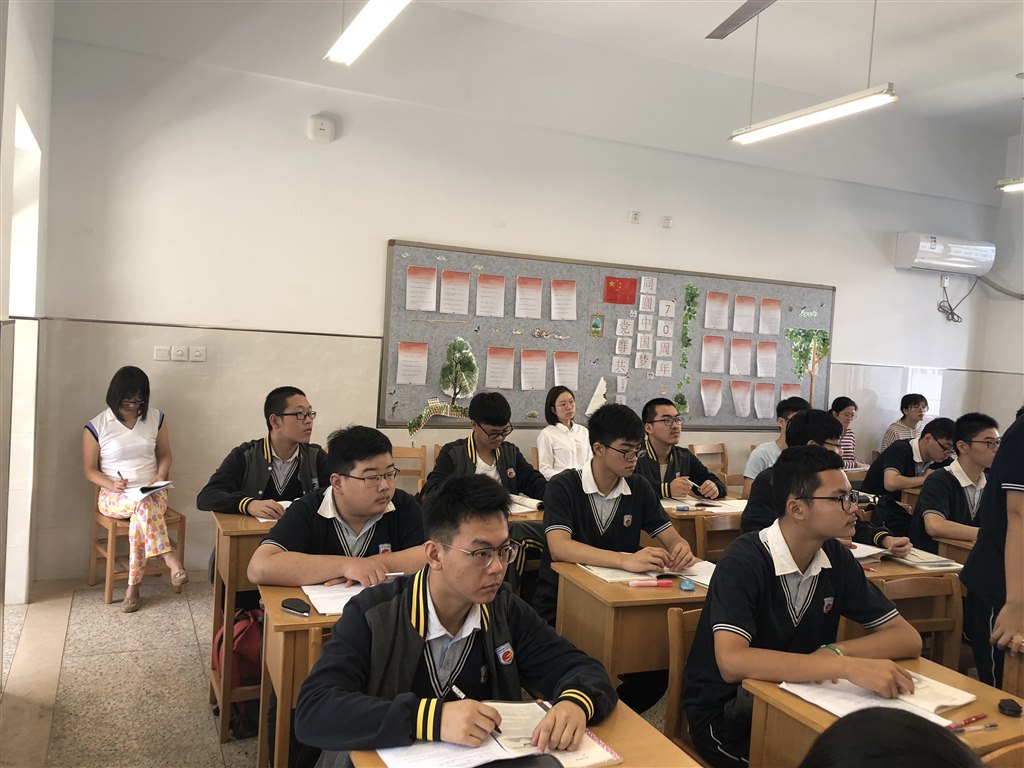

教研组 | 英语 | 开课主题 | M3U2 Reading The economy or the environment—must we choose? |
研究主题 | 如何在英语阅读教学中提升学生的思维品质 | ||
开课教师 | 潘祎明 | 开课班级 | 高二(4)班 |
开课时间 | 周四第叁课(9月19日) | 开课地点 | 弘毅楼302 |
课前与研究主题有关的理论学习记载 | 思维品质是指智力活动中特别是思维活动中智力与能力在个体身上的表现,其实质是人的思维的个性特征。思维品质是区分一个人思维乃至自智力层次、水平高低的指标,主要包括深刻性、灵活性、创造性、批判性、敏捷性五个方面。《普通高中英语课程标准(2017年版)》对英语学科中思维品质的定义则更为聚焦,它认为思维品质是指人的思维个性特征,反映其在思维的逻辑性、批判性、创造性等方面所表现的能力和水平。思维品质体现了英语学科核心素养的心智发展,其发展有助于提升学生分析问题和解决问题的能力,帮助学生从跨文化的视角观察和认识世界,并对事物做出正确的价值判断,促进学生的深度学习。 教师在英语日常教学中,应首先对教学内容进行深入透彻的分析,并从学生现有的水平出发,寻找文本中学生思维的发展点,该发展点可能是思维的某一种品质,如创新性和批判性,也可能是几种品质的结合。基于此,教师要设计出合适的学习活动和任务,并努力提高课堂提问的质量,调动全体学生积极、主动的思维。在课堂教学中,教师要善于抓住课堂生成,发现学生思维的闪光点,及时追问或给予更高的平台,推动学生思维品质的进一步提升。 | ||
课后评价活动记载 | 本课思路清晰,环环紧扣,在培养学生思维的逻辑性、批判性和创造性叁个层次上逐层深入,但最后学生的辩论环节若学生能将上一环节补充的信息运用在自己的论据中会更好 ——姚丽娟 本课条理清晰,从观点、证据和建议叁个方面帮助学生理清文本内容;课前导入视频有难度,且如果最后留给学生更多地准备时间,辩论效果会更好。 ——黄媛婷 本课设计精巧,节奏流畅,让学生在掌握语篇的同时明确辩论的流程和环节,为最终他们自己的辩论做铺垫 ——吕文琦 | ||
课后与研究主题有关的教学反思 | 1. 在让学生分析文本中经济发展对环境有害的几个证据时,提问停留在what(哪个证据不那么使人信服)和why上,可调整设问,并进行内容更具体的追问,在学生回答后帮助他们组织语言,以期更好的效果。 2. 英语辩论对学生的语言能力和思维品质都要求很高,教师在为辩论环节预留充足准备时间的同时,应关注学生的发言内容,并指导他们明确论据,互相沟通。 3. 在下达课堂指令时应该简洁干练,有助于学生快速明确任务。 | ||
附教案:
Learning objectives | By the end of the class, students are able to: | |||
1. know how to read a debate and get information from the text. | ||||
2. think critically and evaluate the text. | ||||
3. give a debate on the same topic based on reading materials and their own knowledge. | ||||
Important & difficult points | 1. let students understand three elements of a good debate and guide them to evaluate the text according to the standard. | |||
2. It may difficult for students to apply the reading materials and give a debate by themselves. | ||||
Teaching methods | Task-based reading | |||
Procedures | ||||
Stage | Teacher’s acts | Students’ expected reaction. | Students’ unexpected reaction | |
Lead-in | 1. Play a debate video before class and then equip students with the definition, debaters and steps of a debate. | Tell what they know about a debate (the positive side & the negative side…) | ||
2. Give three elements of a good debate: clear and relevant view; convincing evidence and workable advice. | Remember them and prepare for the reading. | |||
Reading Para 1 | Ask questions about the topic and debaters of this text. | Read para 1 quickly and find the topic and two debaters. | Students may have the wrong answer or spend too much time reading. | |
Reading Lin Shuiqing’s speech
| 1. Ask students to read Lin Shuiqing’s speech in about 2 minutes. | Read Lin Shuiqing’s speech. | ||
2. Show some blank filling exercise about Lin’s view, evidence and advice. | Try to find Lin’s evidence and advice, and then conclude her view. | |||
3. Ask students to finish the blank filling. | Give their answers of the blank filling. | Students have difficulty in reading the text and give the wrong answer when concluding Lin’s view. | ||
Reading Qian Liwei’s speech | 1. Ask students to read Qian Liwei’s speech in about 2 minutes. | Read Lin Qian Liwei’s speech. | ||
2. Show some blank filling exercise about Qian’s view, evidence and advice. | Try to find Qian’s evidence and advice, and then conclude his view. | |||
3. Ask students to finish the blank filling. | Give their answers of the blank filling. | |||
More about debate | Show more essentials of a debate with the example of the video.
| Keep in mind that in a debate, speakers will represent opposite views on the topic being discussed. | ||
Evaluate the debate in the text | 1. Let students compare Lin and Qian’s view and choose a clearer and more relevant one. | Compare Lin and Qian’s view, choose a clearer and more relevant one and give their reason. | Students cannot possibly explain their reasons clearly. | |
2. Q: Looking back on Lin’s speech, which supporting detail do you think is not that relevant compared to the others? | Analyze Lin’s evidence, evaluate it and express their opinions. | |||
3. Q: Looking back on Lin’s speech, which advice is not that relevant compared to the others? | Analyze Lin’s advice, evaluate it and express their opinions. | |||
Group work | 1. Give another two reading materials and let students find some useful information | Read the materials, and underline useful supporting details to prepare for the debate | Students cannot understand the reading material. | |
2. Ensure that students understand the debate rules and steps | Prepare for their debate speech. | |||
3. Guide students to start their own debate | Each side chooses two members as debaters and start the debate. | Students have difficulty when expressing their views during the debate. | ||